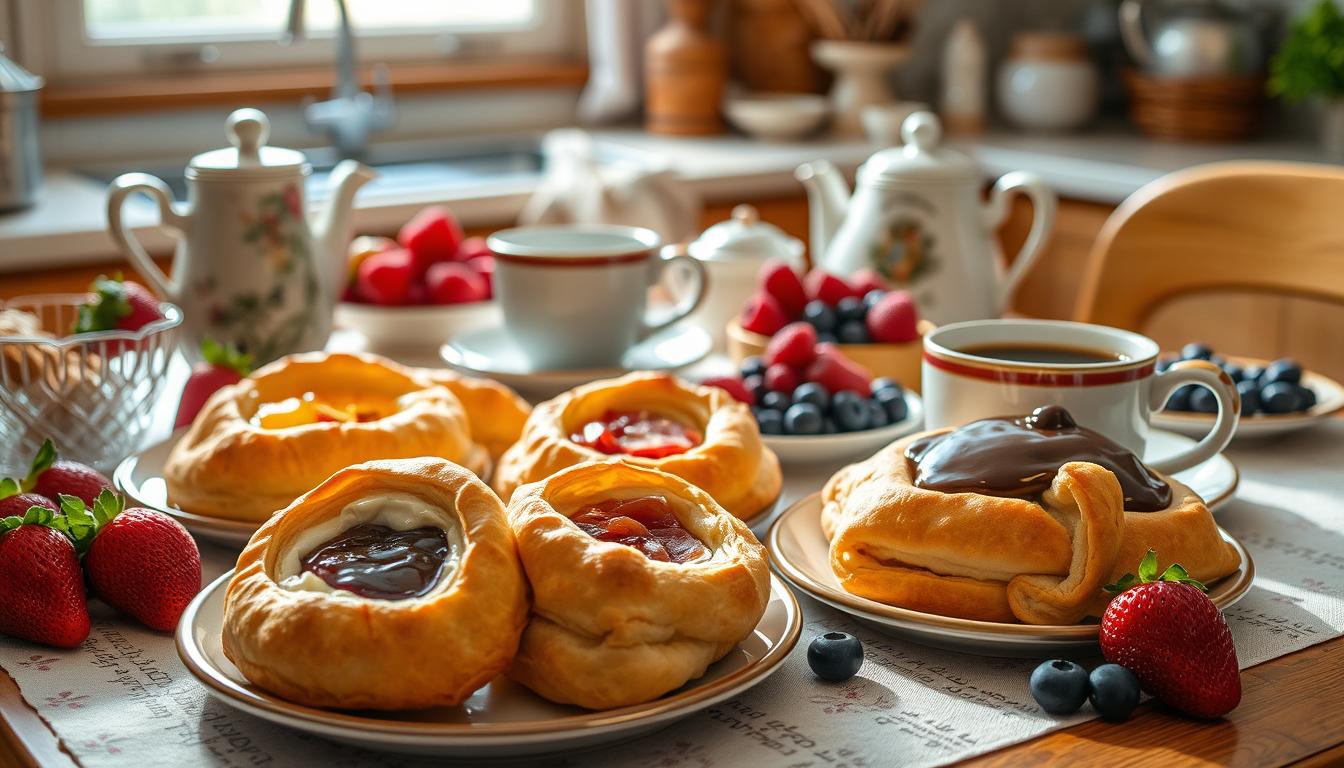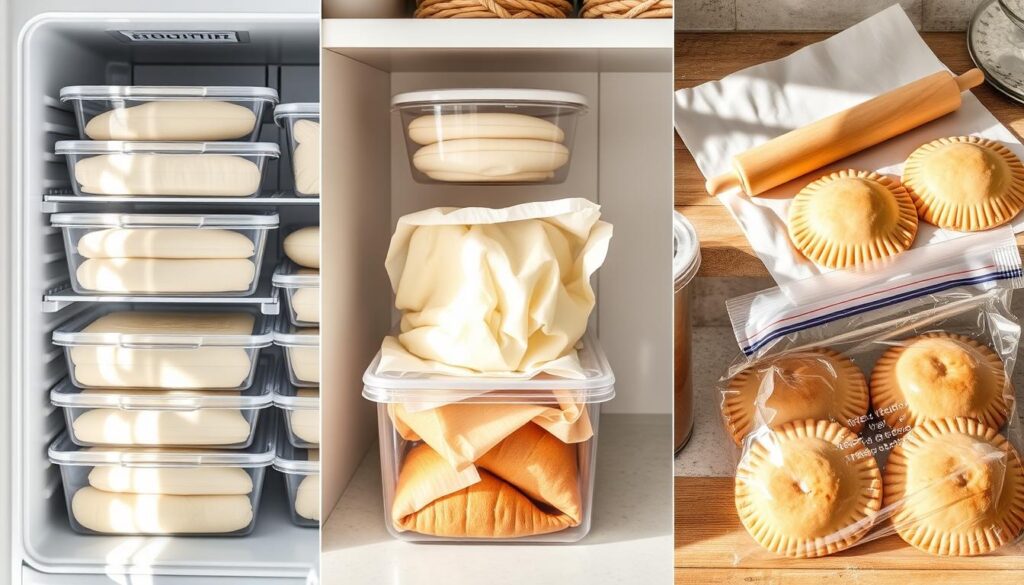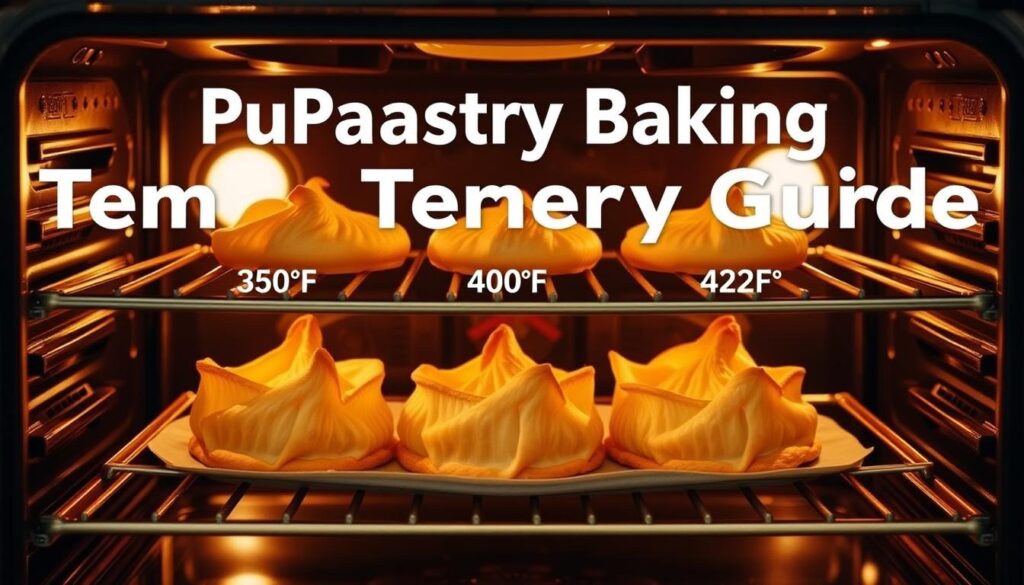Imagine making tasty homemade breakfast pastries with little effort and lots of flavor. This quick puff pastry method lets you turn simple ingredients into beautiful breakfast treats in minutes. It’s perfect for busy home cooks or weekend chefs who want to make homemade pastries.
Our flaky pastry recipe reveals how to make pastries as good as those from a restaurant in your kitchen. You’ll learn to make buttery, crisp layers that break apart perfectly with each bite. It uses basic ingredients and simple steps that anyone can follow.
Key Takeaways
- Create delicious homemade breakfast pastries in just 10 minutes
- Master the art of quick puff pastry with minimal ingredients
- Explore versatile filling options for sweet and savory variations
- Achieve professional-level flaky texture at home
- Impress family and friends with bakery-quality breakfast treats
Essential Ingredients for Quick Homemade Puff Pastry
Making homemade puff pastry is all about the right ingredients. They turn simple parts into a flaky, buttery treat. It’s all about choosing and mixing the right stuff.
Choosing the Right Butter Type
High-quality cold butter is key to great puff pastry. Bakers say European-style butter with more butterfat is best. It gives:
- Richer flavor
- Better texture
- More flakiness
Flour and Cold Water Ratios
Getting the flour and cold water right is important. Use:
- 2 cups of all-purpose flour
- ½ cup of ice-cold water
- ¼ teaspoon salt for salted butter
- ¾ teaspoon salt for unsalted butter
“The secret to flaky pastry lies in keeping everything cold and handling the dough minimally.” – Professional Pastry Chef
Additional Ingredients for Perfect Texture
Some bakers add a bit more to their mix. A tiny pinch of sugar helps with browning. And keeping everything cold and handling it gently is key to perfect pastry.
Equipment and Tools Required for Success
Making tasty breakfast pastries needs the right kitchen tools. Start by picking top-notch equipment. It makes cooking easier and more fun.
- A 14-cup food processor with a metal blade
- Sturdy rolling pin for even dough rolling
- Baking sheet with proper dimensions
- Sharp kitchen knives
- Parchment paper
- Pastry brush
When picking a baking sheet, think about size:
| Pan Type | Dimensions | Recommended Use |
|---|---|---|
| Full Sheet Pan | 26 x 18 x 1⅛ inches | Large batch baking |
| Half Sheet Pan | 13 x 18 x 1⅛ inches | Home kitchen standard |
| Quarter Sheet Pan | 9 x 13 x 1⅛ inches | Small batch or single recipe |
Your food processor is key for mixing ingredients fast. A 14-cup model is big enough for most home recipes.
“The right tools transform good baking into great baking.” – Professional Baker’s Wisdom
Pro tip: Spend on quality tools that last. Stainless steel and strong baking sheets mean better results every time.
Step-by-Step Preparation Method
Making homemade pastries is all about mastering the quick puff pastry method. You’re on your way to making flaky, buttery treats. It all starts with knowing the right techniques and approaches.
Food Processor Technique
The food processor dough method changes the game for pastry making. Here’s what you need to do:
- Chill all ingredients before starting
- Cut cold butter into small cubes
- Pulse flour and butter in short bursts
- Add ice-cold water gradually
- Mix until dough just comes together
Pro tip: Avoid overworking the dough to maintain maximum flakiness!
Dough Rolling Instructions
Your rolling technique is key to the pastry’s texture. Start by lightly flouring your work surface. Roll the dough into a 15×8 inch rectangle, keeping the pressure even.
Folding Techniques for Flaky Layers
To get those flaky layers, you need to fold the dough just right. The lamination process involves strategic folds that create multiple butter layers:
- Perform a three-fold technique
- Chill dough for 20-30 minutes between folds
- Repeat folding process 3 times
- Rest dough for at least 4 hours
Tip: Keep dough temperature between 65-70°F for optimal results.
By following these steps, you’ll turn simple ingredients into a spectacular pastry base. It will rise beautifully and have incredible texture.
Time-Saving Tips and Tricks
Learning efficient baking methods can make making pastry fast and easy. The key is to plan well and use smart techniques. This way, you get delicious results without spending too much time.
“Great pastries don’t have to take hours – they just need smart planning!” – Professional Baker’s Wisdom
Here are some top strategies to streamline your pastry preparation:
- Prepare ingredients in advance by pre-measuring and chilling butter cubes
- Use a food processor for rapid dough preparation
- Make dough ahead of time and refrigerate overnight
- Preheat the oven while preparing fillings
- Cut pastries into smaller sizes for quicker cooking times
Knowing the science behind quick pastry tips can cut down your baking time a lot. For example, puff pastry can make tasty treats in under 30 minutes. Danish pastries can be ready in just 10 minutes per batch, making homemade pastries easier than ever.
| Technique | Time Saved | Difficulty Level |
|---|---|---|
| Food Processor Dough | 30-40 minutes | Easy |
| Pre-Chilled Ingredients | 20-25 minutes | Medium |
| Overnight Dough Resting | 1-2 hours | Simple |
Pro tip: Use shelf-stable ingredients like canned or frozen fruits. This lets you make pastries all year round with little effort.
By using these efficient baking methods, your kitchen will become a fast and easy place to make pastries. The key is to be smart, not to work too hard!
Classic Breakfast Pastries Variations
Exploring breakfast pastry recipes is a fun journey. It lets you discover new flavors and textures. You can find both savory and sweet pastries to delight your taste buds.
Ham and Cheese Roll-Ups
Make tasty savory pastries with ham and cheese. Use thin ham slices and Gruyere cheese. Roll them up tightly for a flavor that melts in your mouth.
Sweet Fruit-Filled Delights
If you love sweet treats, check out these fruit-filled pastries:
- Pear and walnut crescents with chocolate chips
- Apple cinnamon-filled pastries
- Cranberry and cream cheese combinations
Creative Savory Morning Combinations
Try new savory pastries with unique fillings. Double cheese twists with Parmesan and herbs are great. You can also make a Thanksgiving breakfast pastry with exciting flavors.
“A great breakfast pastry is like a morning hug for your taste buds!” – Pastry Chef Emma Roberts
Great breakfast pastries come from creativity and quality ingredients. Whether you like sweet or savory, these options will make your morning special.
Storage and Make-Ahead Options
Learning how to store puff pastry can change your morning routine. Freezing the dough lets you make tasty pastries ahead of time. This saves you a lot of morning time.
Here are key tips for storing puff pastry:
- Wrap the dough tightly in plastic wrap
- Place in a freezer-safe bag
- Store in the refrigerator for 2-3 days
- Freeze for up to one month
Thawing frozen pastry takes time. Move the dough from the freezer to the fridge overnight. This slow thawing helps keep the layers intact and flaky.
“Proper storage is the secret to maintaining your puff pastry’s flaky perfection.” – Pastry Chef Recommendation
For the best taste, follow these storage tips:
| Storage Method | Duration | Best Practices |
|---|---|---|
| Refrigerated (Raw Dough) | 2-3 days | Wrap in plastic, seal tightly |
| Frozen (Raw Dough) | Up to 1 month | Use freezer-safe bag, label with date |
| Baked Pastries | Up to 2 days | Room temperature or refrigerated |
Pro tip: Always let your pastries cool completely before storing to prevent moisture buildup.
Common Mistakes to Avoid
Baking perfect puff pastry needs precision and careful technique. Even skilled home bakers face challenges that can ruin their pastry’s quality. Knowing common puff pastry tips can help you avoid frustrating baking mistakes and get professional-looking results.
Temperature Control Challenges
Temperature is key in pastry troubleshooting. Warm ingredients can mess up the delicate butter layers that make it flaky. The U.S. Department of Agriculture says to use butter with at least 80% butterfat to keep it structured during baking.
- Keep ingredients and work surfaces cold
- Refrigerate dough between folding stages
- Avoid handling dough with warm hands
Handling and Rolling Difficulties
Proper dough handling is crucial for those signature layers. Overworking can make the pastry tough. Chef experts say to handle it lightly to keep the butter layers intact.
- Roll dough gently and evenly
- Use light, consistent pressure
- Chill dough between folding steps
Baking Troubleshooting Techniques
Baking mistakes can quickly ruin your puff pastry. Watch your oven closely to prevent common issues like uneven browning or soggy bottoms. The best baking temperature is between 180-200°C for the best results.
“Prevention is better than correction in pastry baking” – Professional Baker’s Wisdom
- Avoid opening the oven during first 75% of baking
- Use aluminum baking sheets for even heat distribution
- Cover with foil if pastries brown too quickly
Mastering these puff pastry tips will make your home baking better. You’ll create delicious and beautiful pastries every time.
Filling Ideas and Flavor Combinations
Exploring creative pastry fillings can make your breakfast special. Sweet and savory mixes offer endless options for tasty morning treats. They will surely excite your taste buds.
Now, let’s look at some exciting pastry filling ideas to boost your breakfast:
- Sweet Fruit Combinations:
- Pear with toasted walnuts and dark chocolate chips
- Caramelized apple slices with cinnamon and brown sugar
- Mixed berry compote with cream cheese
- Savory Breakfast Fillings:
- Ham and Swiss cheese with fresh asparagus
- Spinach and feta cheese blend
- Scrambled eggs with crispy bacon bits
“The secret to amazing pastry fillings is balancing flavors and textures.”
When picking pastry fillings, keep these nutritional tips in mind. A breakfast tart has 379 calories and 11g of fat. A turnover is lighter, with just 103 calories. You can try different mixes to fit your diet.
Pro tip: Use cheeses like Monterey Jack and Swiss for rich flavor. Be bold with seasonal ingredients or your favorites. Your morning pastries can be a creative outlet!
Perfect Baking Temperature and Timing
To get the perfect golden-brown puff pastry, you need to control the temperature and timing well. The baking temperature is key to creating those flaky layers you love.
When baking puff pastry, timing is everything. Experts say to follow a consistent method to get perfect results every time.
Oven Settings Guide
For most puff pastry recipes, here are the temperature guidelines:
- Preheat your oven to 375°F (190°C)
- Typical baking time ranges from 15-25 minutes
- Adjust timing based on pastry size and filling
Visual Doneness Indicators
Knowing when your pastries are done is more than just timing. Look for these signs:
- Golden-brown color across the entire surface
- Fully puffed and expanded layers
- Crisp, flaky exterior
- Egg-washed pastries should have a shiny, glossy finish
“The secret to perfect puff pastry is patience and precision in temperature control.” – Professional Pastry Chef
Pro tip: If using an air fryer or convection oven, reduce baking time by 2-3 minutes to prevent over-browning. Always watch your pastries closely during the final minutes of baking to ensure they reach that perfect golden-brown perfection.
Serving Suggestions and Presentation Tips
Improving your breakfast pastry presentation can make your morning meal unforgettable. Studies show that how food looks greatly affects how tasty it seems. People find dishes that look good 29% more appealing.
Here are some tips for serving your homemade breakfast pastries:
- Choose elegant platters that match the pastry’s color and texture
- Make your presentation stand out by stacking or using tiered stands
- Add fresh garnishes like herb sprigs or fruit slices
- Sprinkle sweet pastries with powdered sugar for a fancy look
For savory pastries, pair them with a small side salad. This makes your dish look better and adds to the meal. Chefs say to keep your plate simple with no more than six elements.
Presentation is the art of making food look as delightful as it tastes.
Offer a mix of sweet and savory pastries to please everyone. Use decorative pottery or unique platters to make your presentation even more special.
The aim is to create a spread that’s as inviting as it is delicious. With these tips, your breakfast pastries will be a feast for the eyes as well as the taste buds.
Adding Creative Toppings and Glazes
Make your homemade breakfast pastries stand out with amazing toppings and glazes. These can turn simple treats into unforgettable dishes. Learning how to glaze can make your baked goods look and taste better.
Getting good at glazing breakfast pastries takes practice. There are about 12 different ways to glaze, each with its own look and taste.
- Egg Wash Techniques:
- Whole egg for golden shine
- Egg yolk for deep brown color
- Egg white for subtle sheen
- Sweet Glazing Options:
- Powdered sugar with milk
- Fruit juice-based glazes
- Chocolate drizzle
- Savory Topping Ideas:
- Sesame seeds
- Everything bagel seasoning
- Grated cheese
Professional bakers share some key tips for glazing. Add ½ teaspoon of water to egg yolk for enhanced shine and browning. When glazing, brush gently to keep the pastry’s delicate shape.
“The right glaze can transform a simple pastry into a culinary masterpiece” – Pastry Chef Insights
Creative toppings can make your breakfast pastries look up to 80% better. Try using candied orange slices, dried raspberries, or butterscotch sauce. These can make your morning treats unforgettable.
Conclusion
Now you can make tasty homemade breakfast pastries easily. This quick puff pastry recipe turns your morning into a gourmet treat. You can try many fillings, from savory ham and cheese to sweet fruit.
Sharing your homemade pastries with family and friends will wow them. You’ll learn to control temperature and use precise techniques. This way, you’ll make treats as good as those from a bakery.
Keep practicing to get better at making puff pastry. You’ll love baking fresh, flaky pastries that make breakfast special. Just be patient, creative, and enjoy the yummy results.
This recipe is great for both new and experienced bakers. It lets you create amazing breakfast dishes in your kitchen. Your kitchen will become a place for fun morning creations.
FAQ
How long does it take to make homemade puff pastry?
Can I use unsalted butter instead of salted butter?
Do I need a food processor to make this puff pastry?
How long can I store the homemade puff pastry?
What are some popular filling options for these pastries?
What baking temperature is best for puff pastry?
How can I prevent my pastries from leaking filling?
Can I make these pastries ahead of time?
Source Links
- Easy, Flaky, Cheesy Spring Puff Pastry Breakfast – Right Back Spatula – https://rightbackspatula.com/2023/04/16/easy-flaky-cheesy-spring-puff-pastry-breakfast/
- Homemade Breakfast Pastries (Recipe + Video) – Sally’s Baking Addiction – https://sallysbakingaddiction.com/breakfast-pastries/
- Quick & Easy Homemade Puff Pastry – https://anitalianinmykitchen.com/puff-pastry/
- Handmade Puff Pastry (Rough Puff Method) – Sally’s Baking Addiction – https://sallysbakingaddiction.com/rough-puff-pastry/
- Easy 15-Minute Homemade Puff Pastry – Lion’s Bread – https://www.lionsbread.com/15-minute-homemade-puff-pastry/
- Baking Equipment and Utensils – https://pastrieslikeapro.com/baking-equipment-utensils/
- The ultimate checklist of essential baking equipment, recommended by experts – https://www.bbcgoodfood.com/howto/guide/baking-equipment
- Homemade Breakfast Pastries – https://redstaryeast.com/blog/homemade-breakfast-pastries/
- How to Make Puff Pastry, According to the Fearless Baker – https://food52.com/blog/9742-how-to-make-puff-pastry-step-by-step?srsltid=AfmBOorZnl4HxdA9_Q04IMtqD_Xu8SAVlE3dm9nc-k-YKtLUITKdEPHp
- Homemade Pastry Dough (Shortcut Version) – Sally’s Baking Addiction – https://sallysbakingaddiction.com/danish-pastry-dough/



